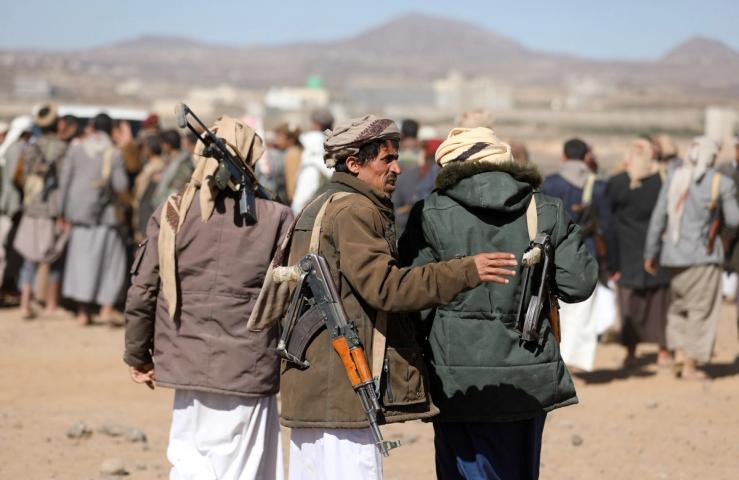The Scoop
Commanders and advisors from Iran’s elite Islamic Revolutionary Guard Corps are on the ground in Yemen and playing a direct role in Houthi rebel attacks on commercial traffic in the Red Sea.
The IRGC has stationed missile and drone trainers and operators in Yemen, as well as personnel providing tactical intelligence support to the Houthis, U.S. and Middle East officials told Semafor. The IRGC, through its overseas Qods Force, has also overseen the transfer to the Houthis of the attack drones, cruise missiles, and medium-range ballistic missiles used in a string of strikes on Red Sea and Israeli targets in recent weeks, these officials said.
The Houthis say that its military operations are designed to aid the Palestinian militant group, Hamas, which has been locked in a three-month war with Israel. On Monday, the Pentagon said the Houthis struck a U.S.-owned and -operated container vessel, the M/V Gibraltar Eagle, in the Red Sea, but caused no significant damage. The Houthis fired a second anti-ship ballistic missile into the southern Red Sea, the U.S. Central Command said, but it “failed in flight and impacted on land in Yemen.”
The IRGC’s overall presence inside Yemen is overseen by Gen. Abdul Reza Shahlai, a Tehran-based commander whom the Trump administration attempted to assassinate in a 2020 drone strike inside Yemen, U.S. and Mideast officials said. American intelligence believes Shahlai is deeply involved in Tehran’s overseas terrorist operations through his role as the Qods Force’s deputy commander.
This includes a role in overseeing an unsuccessful 2011 Iranian plot to assassinate Saudi Arabia’s then-ambassador to the U.S., Adel al-Jubeir, at a Washington, D.C. restaurant. Shahlai, who’s been sanctioned by the U.S. Treasury Department, also helped oversee IRGC attacks against U.S. military personnel in Iraq over the past two decades. The Department of Justice offered $15 million in 2019 for information related to the commander’s operations and networks.
Last month, the White House declassified some information related to Iran’s backing of the Houthis, including the intelligence and targeting support. But it didn’t reference the IRGC’s on-ground presence in Yemen, or Shahlai’s role in the Houthis’ operations.
In this article:
Jay’s view
The IRGC’s ground presence in Yemen, and role in directing strikes against Western targets, risks fueling a direct confrontation with the U.S. as the Israel-Hamas war in the Gaza Strip grinds on. The Biden administration has to date voiced its intent on avoiding a military conflict with Tehran and preventing a wider regional conflagration. But the Pentagon and U.S. allies started directly hitting Houthi targets inside Yemen last week, raising the possibility of the U.S. also harming IRGC personnel.
U.S. and Mideast officials say Tehran began significantly ramping up its military support for the Houthis in the mid-2010s, when the Yemeni militia and political movement engaged in a war with Saudi Arabia and the United Arab Emirates. The Houthis share Iran’s Shiite faith and antipathy to these regional Sunni powers, but had previously been a poorly funded and equipped military force. Today, it has an advanced armory of attack drones and cruise and ballistic missiles that have allowed the Houthis to seriously disrupt global traffic through the Suez Canal and Bab-el-Mandeb Strait and attempt strikes on targets as far away as Israel’s Eilat port.
Current and former U.S. military officials say Iran has developed the Houthis into a central cog in Tehran’s regional alliance system, known as the Axis of Resistance, which includes Hamas in the Palestinian territories, Hezbollah in Lebanon, and Iraqi and Syrian militias. This system allows Iran to project military power well beyond its borders, while also providing some deniability of involvement in military or terrorist operations.
“Iran has the luxury of really fighting, what I would call, a hidden-hand operation, with various Iranians on the ground, Qods Force people, on the ground [in Yemen],” retired Gen. Kenneth McKenize, a former commander of U.S. forces in the Mideast, said last week at a forum on the Red Sea crisis. “First of all, they fought a major war against Saudi Arabia and Yemen, and now they’re choking world shipping in the Bab-el-Mandeb [Strait] at a very low, very low price for Iran.”
The question now is whether the price is set to rise for Iran. Current and former U.S. military and intelligence officials have described to me what is essentially a blood feud between Washington and the IRGC that stretches back decades. Shahlai has played a central role in this covert war.
The U.S. believes the IRGC oversaw Hezbollah suicide bombings on American diplomatic and military targets in Lebanon in the 1980s. And the IRGC is accused of training Iraqi Shiite militias in the use of roadside bombs, known as IEDS, that were the largest cause of U.S. military deaths in Iraq. The U.S. government has also claimed that Shahlai oversaw a 2007 IRGC operation in the central Iraqi city of Karbala that resulted in the executions of five American soldiers.
The View From Tehran
Iran has voiced its support for the Houthis attacks in the Red Sea, claiming that they’re part of the Resistance Axis’ support for Hamas. But Tehran has denied any direct role in either the Houthis’ operations or Hamas’ October 7 attack on Israel.
“The resistance [Houthis] has its own tools… and acts in accordance with its own decisions and capabilities,” Iran’s deputy foreign minister, Ali Bagheri, told Iranian state media last month. “The fact that certain powers, such as the Americans and the Israelis, suffer strikes from the resistance movement… should in no way call into question the reality of the strength of the resistance in the region.”
The Houthis have also denied relying on Iran to conduct its attacks. “It’s strange to attribute everything to Iran as if it were the world’s strongest power,” a Houthi spokesperson told The Wall Street Journal last month. “We have intelligence facilities that have proven themselves over the years of aggression against us.”
Notable
- Alex Vatanka of the Middle East Institute questions whether Iran is willing to risk “open conflict” with the U.S. to defend the Houthis’ operations in the Red Sea and Bab-al-Mandeb Strait.


